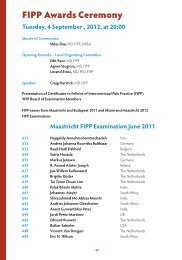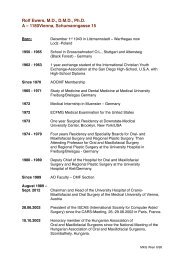adm<strong>in</strong>istration, coupled with an <strong>in</strong>creas<strong>in</strong>g number of reports of serious adverse events,warrants a negative recommendation (2B-). Pulsed radiofrequency treatment adjacent to thecervical dorsal root ganglion is a recommended treatment for chronic cervical radicular pa<strong>in</strong>(1B+) (fig. 2). When its effect is <strong>in</strong>sufficient or of short duration, conventional radiofrequencytreatment is recommended (2B+). In selected patients with cervical radicular pa<strong>in</strong>, refractory toother treatment options, sp<strong>in</strong>al cord stimulation may be considered. This treatment should beperformed <strong>in</strong> specialized centres, preferentially study related.4ReferencesVan Zundert et al: evidence based guidel<strong>in</strong>es <strong>in</strong>terventional pa<strong>in</strong>medic<strong>in</strong> Wiley 2010Chris Wells, MD, MB, CHB, LRCP, MRCS, LMCC, FRCA, FIPPBiographical SketchDr Chris Wells is a consultant anaesthetist who has specialised exclusively <strong>in</strong> Pa<strong>in</strong> Medic<strong>in</strong>e for 31years. He lives and works <strong>in</strong> Liverpool UK. He is President Elect of EFIC, the European Federationof Pa<strong>in</strong> Specialties, and is a Trustee of the WIP Foundation.He has studied the use of Botul<strong>in</strong>um Tox<strong>in</strong> <strong>in</strong> Pa<strong>in</strong> Medic<strong>in</strong>e s<strong>in</strong>ce 1996.LectureBotul<strong>in</strong>um Tox<strong>in</strong>, properties and use <strong>in</strong> Pa<strong>in</strong> medic<strong>in</strong>eObjectivesUpon completion of this presentation attendees will be able to discuss• The history of therapeutic use of Botul<strong>in</strong>um Tox<strong>in</strong> (BT)• The pharmacological properties of BT• The various types of BT and their differ<strong>in</strong>g properties• Possible modes of action <strong>in</strong> pa<strong>in</strong> relief• The therapeutic <strong>in</strong>dications for use <strong>in</strong> pa<strong>in</strong> conditions• Expected outcomes of treatments• Limitations, complications and types of treatment• Future direction <strong>in</strong> use of BTKey Po<strong>in</strong>ts· C Botul<strong>in</strong>um identified <strong>in</strong> 1897, tox<strong>in</strong> purified <strong>in</strong> 1928 and first used medically <strong>in</strong> 1970’s forstrabismus and blepharospasm. Used cosmetically <strong>in</strong> 1980’s.· First use for pa<strong>in</strong> <strong>in</strong> 1990’s for torticollis and headache. Also licensed for other muscle spasms<strong>in</strong>clud<strong>in</strong>g cerebral palsey. Often used off label. Global market approach<strong>in</strong>g $15 billion.· Various different preparations available, with different potencies and properties. Doses notsynonymous across groups. eg Botox, Dysport, Xeom<strong>in</strong>, Myobloc· Few adverse events <strong>in</strong> correct application and dosage. Local pa<strong>in</strong> at <strong>in</strong>jection site, flu-likesymptoms, and unwanted weakness. Potential lethal dose 3000 units of Botox means doselimited to 360u max <strong>in</strong> 12 weeks.· Widely used for therapeutic <strong>in</strong>dications <strong>in</strong>clud<strong>in</strong>g cervical dystonia (spasmodic torticollis)blepharospasm (excessive bl<strong>in</strong>k<strong>in</strong>g), severe primary axillary hyperhidrosis, strabismus,· achalasia, migra<strong>in</strong>e and other headache disorders. Off label use for myofascial pa<strong>in</strong>, piriformissyndrome, focal neuropathies ( <strong>in</strong>clud<strong>in</strong>g diabetic and phn), anal fissure, vag<strong>in</strong>ismus, movementdisorders, dystonias, and sp<strong>in</strong>al cord <strong>in</strong>jury related pa<strong>in</strong>.References• Kukreja R, S<strong>in</strong>gh BR (2009). “Botul<strong>in</strong>um Neurotox<strong>in</strong>s: Structure and Mechanism of Action”.Microbial Tox<strong>in</strong>s: Current Research and Future Trends. Caister Academic Press. ISBN 978-1-904455-44-8.– 30–
• Frank J. Erbguth (2004). “Historical notes on botulism, Clostridium botul<strong>in</strong>um, botul<strong>in</strong>um tox<strong>in</strong>, andthe idea of the therapeutic use of the tox<strong>in</strong>”. Movement Disorders ( John Wiley & Sons on behalf ofthe Movement Disorder Society) 19 (S8): S2–S6. doi:10.1002/mds.20003. PMID 15027048.• Dodick, DW; Turkel, CC, DeGryse, RE, Aurora, SK, Silberste<strong>in</strong>, SD, Lipton, RB, Diener, HC, Br<strong>in</strong>,MF, PREEMPT Chronic Migra<strong>in</strong>e Study, Group (2010 Jun). “Onabotul<strong>in</strong>umtox<strong>in</strong>A for treatment ofchronic migra<strong>in</strong>e: pooled results from the double-bl<strong>in</strong>d, randomized, placebo-controlled phases ofthe PREEMPT cl<strong>in</strong>ical program”. Headache 50 (6): 921–36. doi:10.1111/j.1526-4610.2010.01678.x.PMID 20487038.• Br<strong>in</strong> MF, Lew MF, Adler CH, Comella CL, Factor SA, Jankovic J, O’Brien C, Murray JJ, Wallace JD,Willmer-Hulme A, Koller M (22 October 1999). “Safety and efficacy of NeuroBloc (botul<strong>in</strong>um tox<strong>in</strong>type B) <strong>in</strong> type A-resistant cervical dystonia”. Neurology 53 (7): 1431–1438. ISSN 0028-3878. PMID10534247.• Ranoux D, Attal N, Mora<strong>in</strong> F, Bouhassira D (September 2008). “Botul<strong>in</strong>um tox<strong>in</strong> type A <strong>in</strong>ducesdirect analgesic effects <strong>in</strong> chronic neuropathic pa<strong>in</strong>”. Annals of neurology 64 (3): 274–83.doi:10.1002/ana.21427. PMID 18546285.• Naumann M; So Y; Argoff CE; Childers, M. K.; Dykstra, D. D.; Gronseth, G. S.; Jabbari, B.; Kaufmann,H. C. et al. (May 2008). “Assessment: Botul<strong>in</strong>um neurotox<strong>in</strong> <strong>in</strong> the treatment of autonomicdisorders and pa<strong>in</strong> (an evidence-based review): report of the Therapeutics and TechnologyAssessment Subcommittee of the American Academy of Neurology”. Neurology 70 (19): 1707–14.doi:10.1212/01.wnl.0000311390.87642.d8. PMID 18458231.• FDA Gives Update on Botul<strong>in</strong>um Tox<strong>in</strong> Safety Warn<strong>in</strong>gs; Established Names of Drugs Changed, FDAPress Announcement, August 3, 2009• Foran PG; Mohammed N; Lisk GO; Nagwaney, S; Lawrence, GW; Johnson, E; Smith, L; Aoki, KR et al.(2003). “Evaluation of the therapeutic usefulness of botul<strong>in</strong>um neurotox<strong>in</strong> B, C1, E, and F comparedwith the long last<strong>in</strong>g type A. Basis for dist<strong>in</strong>ct durations of <strong>in</strong>hibition of exocytosis <strong>in</strong> central neurons”.J. Biol. Chem. 278 (2): 1363–71. doi:10.1074/jbc.M209821200. PMID 12381720.Aaron Calodney, MD, FIPPBiographical SketchAaron Kenneth Calodney, MD is Past President of the Texas Pa<strong>in</strong> Society. He currently sits on theBoard of Directors of the American Society of Interventional Pa<strong>in</strong> Physicians (ASIPP. Dr. Calodneyis board-certified <strong>in</strong> Anesthesiology and carries subspecialty certification <strong>in</strong> Pa<strong>in</strong> Managementthrough the American Board of Anesthesiology. Dr. Calodney earned his medical degree fromthe University of Missouri School of Medic<strong>in</strong>e and completed a family medic<strong>in</strong>e <strong>in</strong>ternship atSt. Joseph’s Hospital <strong>in</strong> Syracuse, New York. His residency <strong>in</strong> anesthesiology and subsequent<strong>in</strong>terventional pa<strong>in</strong> management fellowship was completed at the University of Texas HealthScience Center at Houston. He subsequently completed a fellowship <strong>in</strong> pediatric anesthesia atthe Denver Children’s Hospital. With particular <strong>in</strong>terest <strong>in</strong> sp<strong>in</strong>e and special <strong>in</strong>terests <strong>in</strong>clud<strong>in</strong>gneuromodulation and <strong>in</strong>trathecal drug delivery, biological treatment of the pa<strong>in</strong>ful degenerativedisc, peripheral nerve <strong>in</strong>jury and radiofrequency ablation, Dr. Calodney has presented andpublished many articles and textbook chapters. He is actively <strong>in</strong>volved <strong>in</strong> cl<strong>in</strong>ical research andhas delivered over 250 <strong>in</strong>vited lectures <strong>in</strong> the US and abroad. Dr. Calodney is a member ofthe American Society of Anesthesiologists, American Society of Regional Anesthesia and Pa<strong>in</strong>Medic<strong>in</strong>e, and many other elite medical societies. He is an author of the first Evidence BasedTreatment Guidel<strong>in</strong>es <strong>in</strong> Interventional Pa<strong>in</strong> and Evidence Based Guidel<strong>in</strong>es for the Use ofOpioids published <strong>in</strong> the Pa<strong>in</strong> Physician journal and on the National Guidel<strong>in</strong>e Clear<strong>in</strong>ghouse.LectureNeuromodulation– 31–
- Page 1 and 2: - 1-
- Page 3 and 4: ContentGreetings...................
- Page 5 and 6: speakers. The local arrangements ch
- Page 7 and 8: Directors:Charles Amaral de Oliveir
- Page 9 and 10: Registration Fee (Regular Fees afte
- Page 11 and 12: - 11-
- Page 13 and 14: TUESDAY, 27 August, 2013 - Sofitel
- Page 15: FIPP Awards CeremonyMaster of Cerem
- Page 19 and 20: LectureLumbosacral Spinal Canal End
- Page 21 and 22: LectureTarlov Cysts Plus Alternativ
- Page 23 and 24: tissue inside the epidural space, m
- Page 25 and 26: 1. Maigne JY, Aivakiklis A, Pfefer
- Page 27 and 28: • By delivering RF in intermitten
- Page 29: INNOVATION FOCUSED ON PAIN RELIEF C
- Page 33 and 34: • Levels of exposure. Work-relate
- Page 35 and 36: Dr. Justiz is board certified in An
- Page 37 and 38: Andrea M. Trescot, MD, FIPPBiograph
- Page 39 and 40: Sang Chul Lee, MD, MD, PhD, FIPPBio
- Page 41 and 42: Introducing our newcorporate websit
- Page 43 and 44: Epimed International Inc.Crossroads
- Page 45 and 46: AUTHORS INDEXMert Akbas............
- Page 47 and 48: Big thingscome in smallpackages.Wit











